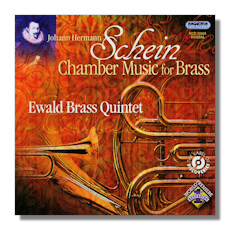
The Internet's Premier Classical Music Source
Related Links
- Schein Reviews
- Latest Reviews
- More Reviews
-
By Composer
-
Collections
DVD & Blu-ray
Books
Concert Reviews
Articles/Interviews
Software
Audio
Search Amazon
Recommended Links
Site News
 CD Review
CD Review
Johann Hermann Schein

Chamber Music for Brass
- Music for Brass
- Suite
- Four-part dances from Banchetto Musical
- Little Suite
- Chorales for Brass Ensemble
Gábor Komlössy, tuba
Ewald Brass Quintet
Hungaroton HCD32618
Not for nothing are Schütz, Scheidt and Schein often grouped together. All born within the same two year period (between 1585 and 1587), and living close to one another geographically, they were also friends. Equally gifted and with not dissimilar professional careers, the three composers moved in the same world. Yet there is much to distinguish them one from another; their idioms and musical pre-occupations are not interchangeable. Schein led the way in adopting innovations of the Italian early Baroque (the monodic style, close attention to the text, the concertato style and use of continuo, for example) into the north German musical world. This is remarkable: unlike Schütz, Schein never left Saxony and Thuringia&Hellip; he preceded Bach at the Thomaskirche, Thomasschule and Nicolaikirche in Leipzig.
Schein's œvre is divided roughly equally into sacred and secular vocal works – some of the latter of very "robust" hue. They were published in a variety of forms and collections; a detached survey of them reveals a distinct range of emotional and musical styles and approaches. Very much the confident output of a composer at ease with himself and his material. This recording featuring the polished playing of the Ewald Brass Quintet presents almost four dozen pieces drawn from divers sources, only three lasting more than three minutes. But partly because these are from collections, there is rarely a suggestion of scattering or disjointedness. Some are dances without specified instruments and brass arrangements of chorales. It is a collection – as a selection – and does not pretend to be a unified whole in any way.
The first thing you will notice is probably the businesslike, almost "regimented", structure and pace at which the Ewald Brass Quintet plays the music. This is rarely perfunctory; although by about a third of the way through the momentum has taken sufficient hold for the succession of apparently self-contained pieces to have generated a life of its own, when in fact the particularities of each should count for more. It's hard to see how this could have been avoided though. And their playing is never mechanical: listen to the polyphony of the Intrade from the Suite [tr.14], which is full of life and humor. So nothing even approaching mechanical – still less cursory – in the way the Quintet lays out one after another of these compelling little pieces. But more professional than romantic. Not that feeling is lacking: the Pavan from the same Suite [tr.16], for example, is almost wistful.
Nor do the players ever lose sight of the liveliness or vigor with which these dance movements and suites are best imbued. Just that the dances would be written for a somewhat formal milieu. Certainly more courtly than rustic. Somehow this tone suits the music of Schein in the same sort of way that it does Gabrieli, or even Bach. At times you feel that the flavor which the Quintet is aiming for comes just a little too close to that of the modern brass band – in the second allemande from the four-part dance selection from the Banchetto Musicale [tr.22] for instance. A little too jaunty.
The Ewald Brass Quintet was founded in 1996. The fact that they have won several brass competitions will come as no surprise when you hear their precision, control and facility with some of the more complex tempi and melodic counterpoint. The acoustic is good, clear and with just the right amount of atmosphere. The booklet from Supraphon has a useful background essay, but lacks full descriptions of the works or their provenance. As an enjoyable and pleasing representative sample of this corner of Schein's work, though, this CD has a lot to recommend it.
Copyright © 2009, Mark Sealey



















